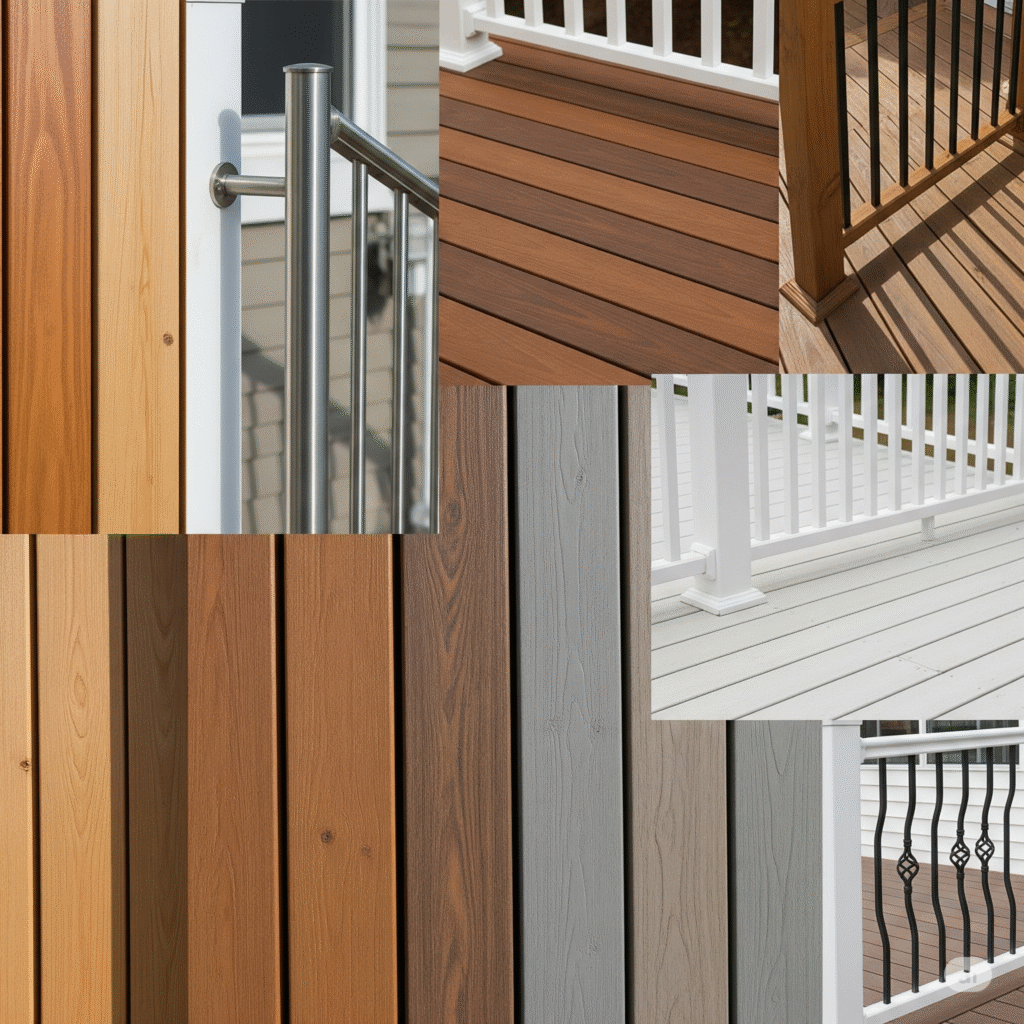materials and finishes
Materials and Finishes: Choose the Best Deck Options to Save Time & Money
Deck materials and finishes form the backbone of any successful deck project. At their core, materials refer to the substances used to build the structure think wood, composite, PVC, or metal—while finishes are the protective or decorative coatings applied to those materials, like stains, sealers, or paints.
Choosing the right combination isn’t just about looks. Durability plays a huge role, especially in climates like Florida’s, where humidity and sun exposure can accelerate wear. A well-chosen material can last 10 to 30 years depending on type and upkeep, while finishes protect against moisture, UV damage, and daily wear.
Cost-efficiency also weighs heavily. For example, pressure-treated lumber often costs between $2 and $5 per square foot, making it an economical choice for many homeowners. Composite decking, while pricier—typically $7 to $12 per square foot—cuts down on maintenance time and expenses, often paying for itself over the years.
Common materials on the market break down roughly like this:
- Wood: Pressure-treated pine, cedar, redwood, tropical hardwoods
- Composites: Blends of wood fibers and plastic for low maintenance
- PVC and Synthetic: Durable, lightweight, and highly resistant to weather
- Metal: Aluminum decks for strength and longevity in niche cases
Finishes include:
- Stains: Enhance natural wood grain while offering protection
- Sealers: Provide moisture barriers without altering appearance much
- Paints: Offer solid color and surface protection but require more upkeep
Deciding which materials and finishes suit a project requires balancing aesthetics, budget, and lifespan. Armed with this knowledge, the next steps—whether design, budgeting, or installation—fall into place more smoothly.
Picking the right materials today means fewer headaches tomorrow and a deck that stands strong through years of gatherings, sunrises, and everything in between.

Common Deck Materials Explained
When it comes to decking, the choice of material sets the tone for your entire project—impacting appearance, maintenance, and longevity. Here’s a clear breakdown of the most popular materials and what each brings to the table.
Wood Decking Materials
Wood remains a favorite thanks to its natural beauty and versatility. Key types include:
- Pressure-Treated Lumber
The budget-friendly workhorse of decks. Treated to resist rot and insects, it typically costs $2–$5 per square foot. Lifespan ranges from 10 to 15 years but requires annual sealing or staining to keep it looking good. - Cedar
Naturally resistant to decay and insects, cedar offers a warm, rich tone. Prices fall around $4–$7 per square foot. It’s softer than hardwoods, so dents and scratches are common, but with proper care, cedar decks can last 15 to 20 years. - Redwood
Known for its deep red hues and excellent durability, redwood is pricier—about $5–$8 per square foot. It resists warping and splitting well and can last up to 25 years with regular maintenance. - Tropical Hardwoods (Ipe, Mahogany, Tigerwood)
These dense woods are prized for durability and rich colors. They cost $8–$15 per square foot, often require pre-drilling due to hardness, and can last 25 to 40 years with minimal upkeep.
Composite and Synthetic Decking
Composites blend wood fibers with plastic polymers to create decking that looks like wood but resists fading, warping, and insect damage.
- Pros: Low maintenance, no need for staining or sealing, often backed by 25–30 year warranties
- Cons: Higher upfront cost ($7–$12 per square foot), can be hotter underfoot in direct sun
These materials are perfect for those who want a wood look with less fuss, especially in high-moisture areas.
Alternative Materials
- PVC Decking: 100% plastic decking that’s ultra-resistant to moisture, fading, and staining. Priced similarly to composites but lighter and often featuring more color options.
- Aluminum Decking: Strong, lightweight, and impervious to rot and insects. Best suited for modern designs, though costlier and less common.
Finishes for Decks: Protection and Style
Deck finishes protect materials from weather and wear while enhancing appearance.
- Stains:
- Transparent: Shows wood grain, less UV protection
- Semi-transparent: Balances color and protection
- Solid: Covers imperfections, strongest defense
- Sealers: Clear barrier against moisture, often reapplied yearly.
- Paints: Full coverage and color options but require more upkeep due to chipping.
- Eco-Friendly Finishes: Low-VOC, water-based options reduce fumes and environmental impact.
Choosing the right finish preserves your deck and cuts future repair costs.
Cost Considerations for Materials and Finishes
Budgeting for a deck starts with understanding material and finish costs, which can vary widely based on quality and type.
- Material Costs:
- Pressure-treated wood: $2–$5 per sq ft
- Cedar and redwood: $4–$8 per sq ft
- Composite decking: $7–$12 per sq ft
- PVC and aluminum: Often $10+ per sq ft
- Finish Costs:
- Stains and sealers typically run $25–$50 per gallon, covering about 200–300 sq ft.
- Paints may cost slightly more, with added labor if repainting is frequent.
Long-term savings come from choosing materials and finishes that lower maintenance and replacement needs. For instance, composites might cost more upfront but reduce upkeep expenses by up to 50% over 10 years.
A typical 12×20 deck might cost anywhere from $1,200 with basic wood and finishes to $5,000 or more using premium composites and eco-friendly coatings. Factoring in these details early helps avoid surprises and keeps your project on track.
Calculating Materials: Tools and Resources
Accurate material estimation is key to avoiding costly overruns or waste. Several free and easy-to-use calculators help homeowners plan their deck projects:
- Home Depot Deck Material Calculator: Estimates lumber, fasteners, and finishes based on deck size and design.
- Lowe’s Deck Material Calculator: Offers detailed breakdowns with options for different materials.
- Online Deck Material List Calculators: Tools like Deck Designer or free downloadable spreadsheets help customize lists for specific layouts.
These calculators typically require inputs like deck dimensions, joist spacing, and railing preferences. Using them reduces guesswork and ensures you buy just what’s needed—saving money and minimizing leftover scraps.
Pairing these tools with a solid material list sets a firm foundation for smooth budgeting and timely completion.
Deck Design Tools: Plan Your Deck with Confidence
Designing your deck before buying materials can prevent costly mistakes and bring your vision to life. Several free and paid tools make this process accessible and straightforward:
- Free Online Deck Design Software:
Platforms like SketchUp, Trex Deck Designer, and Home Depot’s Deck Designer allow you to create detailed 3D models. These tools help visualize layout, materials, and finishes before you commit. - Benefits of Using Design Tools:
- Accurate material estimates linked to your design
- Experiment with styles, colors, and dimensions easily
- Spot potential issues early, avoiding costly rework
By combining design software with material calculators, homeowners get a clear roadmap—balancing aesthetics, budget, and practicality from the start. This approach streamlines purchasing and speeds up installation, turning ideas into reality with less hassle.
Choosing Materials and Finishes for Your Climate and Lifestyle
Your deck’s environment shapes the best materials and finishes to use. In places like Florida, with intense sun, high humidity, and pests, durability and resistance are non-negotiable.
- Humidity and Moisture: Pressure-treated wood and composites resist rot and swelling better than untreated wood.
- Sun Exposure: UV-resistant finishes and synthetic materials prevent fading and cracking under relentless sunlight.
- Pest Resistance: Woods like cedar and redwood naturally deter insects, while composites offer a bug-proof alternative.
Lifestyle matters, too. For low-maintenance living, composites paired with long-lasting finishes cut down on upkeep time. If you prefer natural wood’s warmth, plan for regular sealing and staining to keep your deck looking sharp.
Matching materials and finishes to your local conditions and daily use ensures a deck that stands up to time—and your lifestyle—without constant repair or replacement.
Installation and Maintenance Tips
The right materials are only part of the equation—proper installation and upkeep keep a deck looking great for years.
- Skill Level: Wood decks can be more forgiving for DIYers, while composites and synthetics often require specific tools and experience to install correctly.
- Routine Maintenance: Wood decks need regular cleaning, sealing, or staining—usually every 1 to 3 years—to prevent rot and fading. Composites require less upkeep but benefit from annual washing.
- Professional Help: Hiring experienced deck builders ensures proper structural integrity, code compliance, and finish application, which can save costly repairs down the road.
Maintaining your deck isn’t a chore when the right materials and care align. Simple seasonal tasks extend lifespan and keep your outdoor space safe and inviting through changing seasons
Local Resources and Where to Buy
Sourcing quality materials nearby can save time and offer expert guidance tailored to your area’s climate and building codes. Major retailers like Home Depot and Lowe’s carry a wide range of decking supplies—from pressure-treated lumber to composites and finishes—often with online calculators and design tools to support your planning.
Local deck builders and suppliers provide personalized service and knowledge about what works best in Tampa’s humid environment. They can recommend materials that hold up against Florida’s heat, humidity, and pests, plus offer installation and maintenance advice.
Buying locally not only supports the community but also ensures faster delivery, better product availability, and access to trusted expertise that keeps your deck project on track from start to finish.
